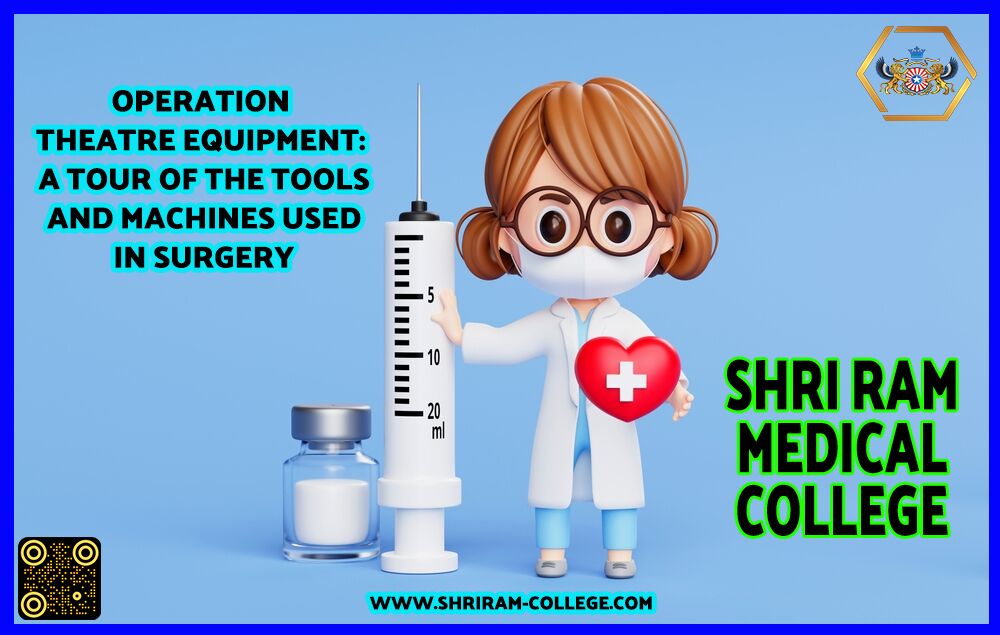No products in the cart.
Operation Theatre Equipment: A Tour of the Tools and Machines Used in Surgery
Introduction
Learn all about the fundamental instruments and machinery used in operating rooms with this thorough overview. Find out more about the complex tools used in medicine to guarantee accuracy and patient safety.
The operating room is the epicentre of contemporary medicine‘s life-saving treatments. The various instruments and machinery that were painstakingly created to assist surgeons in carrying out operations efficiently and precisely are essential to its operation. An intriguing exploration of the vast number of instruments necessary for successful surgery is provided in this article, which dives into the fascinating world of operating room equipment.
Exploring Operation Theatre Equipment
Understanding the Operating Table
Operating tables are essential in any surgical facility because they provide a stable surface for patients to lie on while they are operated upon. Modern operating tables are designed to be stable and versatile, with ergonomic features that help patients be positioned optimally, which in turn makes doctors more accessible and reduces the likelihood of complications.
An Overview of Surgical Lights
Surgeons and their teams are able to see clearly during procedures thanks to surgical lights, which illuminate the surgical field. Because of their ability to provide intense light with very little heat, LED lights have completely altered this component of surgical equipment. They create the ideal working conditions by increasing visibility and decreasing eye strain with their adjustable intensity and color temperature.
Crucial Role of Anesthesia Machines
When it comes to the well-being of surgical patients, anesthesia machines are indispensable. These high-tech tools allow for regulated sedation by delivering exact amounts of anesthetics and medicinal gases. Anesthesiologists can improve patient care and safety with the help of contemporary anesthesia equipment that have sophisticated monitoring capabilities. This allows them to closely monitor vital signs and modify anesthesia levels as needed.
The Significance of Surgical Drapes and Gowns
Patients and surgical staff are protected from infections by using surgical drapes and gowns as a crucial barrier against contamination. The use of these sterile garments during surgery helps to reduce the likelihood of postoperative problems by establishing a sterile area surrounding the operation site. Because they are disposable, there is less chance of cross-contamination, which helps keep the operating room clean.
Essential Role of Surgical Instruments
Surgical instruments include a wide variety of tools that are designed for various types of surgeries. Various surgical instruments, such as forceps, retractors, and hemostats, enable surgeons to delicately and precisely manipulate tissues. Lightweight, ergonomic tools that improve surgical dexterity and reduce fatigue have been developed as a result of advances in materials and manufacturing techniques.
The Evolution of Electrosurgical Units
By utilizing electrical energy to coagulate, seal, and cut tissues, electrosurgical machines have completely transformed surgical practices. Their adaptability and the fact that they allow for precise tissue dissection with little blood loss have made these instruments important in many branches of surgery. These days, surgeons have more control and efficiency than ever before because to electrosurgical devices that have adjustable power levels and sophisticated safety measures.
Role of Endoscopic Systems in Minimally Invasive Surgery
With endoscopic equipment, surgeons can see more clearly and precisely during minimally invasive treatments. Endoscopic surgery uses small cameras and specialized tools to limit tissue stress and incision size, which means less postoperative pain and faster recovery. Endoscopic devices have transformed many branches of surgery, including laparoscopy and arthroscopy.
Innovations in Robotic Surgical Systems
The most cutting-edge technical advancement in contemporary surgery is robotic surgical systems. The combination of robotic arms, high-definition cameras, and powerful software on these platforms allows surgeons to execute intricate procedures with unmatched control and precision. Although robotic surgery is presently pricey and only used in specific fields, it has the potential to enhance patient outcomes and decrease surgical morbidity in the future.
The Importance of Sterilization Equipment
When it comes to preventing infections and keeping surgical instruments in good working order, sterilization equipment is indispensable. To guarantee that instruments are free of pathogens before each use, the sterilizing procedure involves using autoclaves, ethylene oxide sterilizers, and ultrasonic cleaners, among other important components. Preventing the spread of healthcare-associated illnesses and maintaining patient safety requires strict sterilisation practices.
Advancements in Patient Monitoring Systems
By continuously recording the patient’s vital signs—including heart rate, blood pressure, and oxygen saturation—patient monitoring systems let surgeons keep tabs on their health while the operation progresses. In order to allow for quick action in the case of adverse events or physiological abnormalities, these advanced systems provide alarming capabilities in addition to continuous monitoring. By improving documentation and easing interdisciplinary communication, integration with electronic medical records promotes coordinated patient care.
Innovative Imaging Modalities
When it comes to preoperative planning and intraoperative guiding, imaging modalities including X-ray, ultrasound, and MRI are indispensable. Surgeons are better able to plan the best approach and foresee any obstacles with the use of preoperative imaging, which lets them see disease and anatomical features. Accuracy and precision are guaranteed during difficult procedures with the use of intraoperative imaging, which allows for real-time observation of surgical targets.
Ensuring Environmental Control in the Operation Theatre
To ensure that surgical procedures are carried out in an optimal setting, the operation theater’s environmental control systems manage the temperature, humidity, and air quality. The safety of patients, the efficacy of medical equipment, and the avoidance of infections all depend on the meticulous regulation of these parameters. By removing airborne contaminants, high-efficiency particulate air (HEPA) filtration systems create a sterile operating environment and reduce the likelihood of surgical site infections.
Role of Specialty Equipment in Advanced Surgical Procedures
Advanced surgical treatments rely heavily on specialized technology including surgical lasers, navigation systems, and microscopes. Surgical microscopes allow for better visibility during complex procedures, and laser technology allows for accurate tissue ablation and hemostasis. To help surgeons navigate intricate anatomical structures and achieve the best possible surgical results, navigation systems use cutting-edge imaging technology and computer-assisted guiding.
FAQs (Frequently Asked Questions)
Q: What are the essential components of an operation theatre?
A: For the operating room to work well, a number of critical parts are required. Among these, you may find the operating table, an essential piece of surgical equipment. The operating field is illuminated by surgical lights, which provide the surgical team great visibility. Instruments for sterilization are used to keep surgical tools clean and sterile, while devices for administering anesthesia provide regulated sedation. When used together, these elements provide a solid foundation for a surgical setting that is both safe and efficient.
Q: How do endoscopic systems benefit patients?
A: Patients having surgery benefit greatly from endoscopic systems. Among these advantages include shorter recovery times, less scarring due to smaller incisions, and less postoperative discomfort. Endoscopic systems improve surgical experiences and outcomes by utilizing minimally invasive procedures, which enhance patient comfort and encourage better esthetic outcomes.
Q: What is the role of robotic surgical systems in modern surgery?
A: With robotic surgical devices, doctors may perform complex procedures with greater control and precision, which could lead to better patient outcomes with fewer complications. These systems allow surgeons to be more precise and deft thanks to cutting-edge technology, which in turn increases the success rate of procedures while decreasing patient risks. By expanding the limits of what is possible in modern medicine, robotic aid is transforming surgical practice, which is good for patients and doctors alike.
Q: Why is sterilization equipment essential in the operation theatre?
A: When it comes to surgical instruments, sterilization equipment is essential for keeping them free of hazardous bacteria. This helps to reduce the risk of infections and maintains high standards of patient safety. Healthcare institutions can provide a sterile surgical environment by putting tools through rigorous sterilization processes. This reduces the chance of postoperative problems and promotes favorable patient outcomes. Ensuring the safety of patients and the efficacy of surgical procedures depend on rigorous sterilizing protocols.
Q: How do patient monitoring systems contribute to surgical care?
A: Clinicians can quickly assess a patient’s state and respond to any adverse events or physiological anomalies that occur thanks to patient monitoring devices that provide instant access to vital sign data. With the ability to track vital signs in real-time, medical professionals can react quickly to any changes in their patients’ conditions and head off any problems that may arise during treatments. Patient monitoring systems improve clinical outcomes and patient safety by giving complete and current information.
Q: What role do imaging modalities play in surgical procedures?
A: Radiology, ultrasonography, and magnetic resonance imaging (MRI) are some of the imaging modalities that help surgeons see anatomical features and diagnose diseases. Preoperative planning relies heavily on these modalities because they provide precise images that direct surgical techniques and tactics. On top of that, they provide surgeons with real-time intraoperative guidance so they may make educated judgments while operations are underway. Imaging modalities greatly improve surgical accuracy and patient safety by increasing visibility and precision.
Conclusion
Surgical procedures rely on operation theater technology to ensure safe, efficient, and accurate interventions in a range of medical fields. These tools and devices, which may include both classic and cutting-edge technologies, are crucial for improving surgical procedures and getting the best possible results for patients. The surgical field is constantly evolving, and each component, from robotic systems to scalpels, is essential for supporting surgeons and improving patient care.



